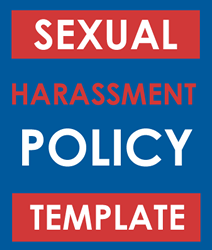 This sample sexual harassment policy is intended for use by nonprofit organizations to help them develop their own sexual harassment policies.
This sample sexual harassment policy is intended for use by nonprofit organizations to help them develop their own sexual harassment policies.
This policy is based on common practices and includes all the components which make a sexual harassment policy comprehensive, and any effective policy must include most if not all of the content of this sample sexual harassment policy.
If you decide to adopt a sexual harassment policy, you should add it to your nonprofit bylaws to make it an effective working policy.
Nonprofit organizations should of course modify certain clauses to meet specific conditions within their organizations. This sexual harassment policy is available in an editable word document format included with the rest of my templates to save you time in copy and pasting.
The Sexual Harassment Policy Statement
[ORGANIZATION’S NAME] is committed to providing a safe environment for all its employees free from discrimination on any ground and from harassment at work including sexual harassment.
[ORGANIZATION’S NAME] will operate a zero tolerance policy for any form of sexual harassment in the workplace, treat all incidents seriously and promptly investigate all allegations of sexual harassment. Any person found to have sexually harassed another will face disciplinary action, up to and including dismissal from employment.
All complaints of sexual harassment will be taken seriously and treated with respect and in confidence. No one will be victimized for making such a complaint.
Definition of sexual harassment in a workplace
Sexual harassment is unwelcome conduct of a sexual nature which makes a person feel offended, humiliated and/or intimidated. It includes situations where a person is asked to engage in sexual activity as a condition of that person’s employment, as well as situations which create an environment which is hostile, intimidating or humiliating for the recipient.
Sexual harassment can involve one or more incidents and actions constituting harassment may be physical, verbal and non-verbal. Examples of conduct or behavior which constitute sexual harassment include, but are not limited to:
Physical sexual conduct
- Unwelcome physical contact including patting, pinching, stroking, kissing, hugging, fondling, or inappropriate touching
- Physical violence, including sexual assault
- Physical contact, e.g. touching, pinching
- The use of job-related threats or rewards to solicit sexual favors
Verbal sexual conduct
- Comments on a worker’s appearance, age, private life, etc.
- Sexual comments, stories and jokes
- Sexual advances
- Repeated and unwanted social invitations for dates or physical intimacy
- Insults based on the sex of the worker
- Condescending or paternalistic remarks
- Sending sexually explicit messages (by phone or by email)
Non-verbal sexual conduct
- Display of sexually explicit or suggestive material
- Sexually-suggestive gestures
- Whistling
- Leering
Explanation note: This section defines sexual harassment. If examples are included, it is important to note that they are not exhaustive and that sexual harassment can include any conduct of a sexual nature which is unwanted and unwelcome by the recipient.
Anyone can be a victim of sexual harassment, regardless of their sex and of the sex of the harasser. [ORGANIZATION’S NAME] recognizes that sexual harassment may also occur between people of the same sex. What matters is that the sexual conduct is unwanted and unwelcome by the person against whom the conduct is directed.
[ORGANIZATION’S NAME] recognizes that sexual harassment is a manifestation of power relationships and often occurs within unequal relationships in the workplace, for example between manager or supervisor and employee.
Anyone, including employees of [ORGANIZATION’S NAME], clients, customers, casual workers, contractors or visitors who sexually harasses another will be reprimanded in accordance with this internal policy.
All sexual harassment is prohibited whether it takes place within [ORGANIZATION’S NAME] premises or outside, including at social events, business trips, training sessions or conferences sponsored by [ORGANIZATION’S NAME].
Sexual harassment Complaints procedures
Anyone who is subject to sexual harassment should, if possible, inform the alleged harasser that the conduct is unwanted and unwelcome. [ORGANIZATION’S NAME] recognizes that sexual harassment may occur in unequal relationships (i.e. between a supervisor and his/her employee) and that it may not be possible for the victim to inform the alleged harasser.
If a victim cannot directly approach an alleged harasser, he/she can approach one of the designated staff members responsible for receiving complaints of sexual harassment. This person could be another supervisor, a member of the human resources department, etc.
When a designated person receives a complaint of sexual harassment, he/she will:
- immediately record the dates, times and facts of the incident(s)
- ascertain the views of the victim as to what outcome he/she wants
- ensure that the victim understands the organization’s procedures for dealing with the complaint
- discuss and agree the next steps: either informal or formal complaint, on the understanding that choosing to resolve the matter informally does not preclude the victim from pursuing a formal complaint if he/she is not satisfied with the outcome
- keep a confidential record of all discussions
- respect the choice of the victim
- ensure that the victim knows that they can lodge the complaint outside of the organization through the relevant country/legal framework
Explanation note: It is important to give the victim options for reporting the matter and this will depend on the structure of the organization. The need for options for reporting is very important because having one person only to report to limits the ability of the victim to avail themselves of the complaints procedure. If for example, the harasser is also the designated person, the designated person is away on leave, or the victim would rather report it to a woman than a man or to a man than a women and the designated person is a man, woman etc.
Throughout the complaints procedure, a victim is entitled to be helped by a counselor within the nonprofit organization. [ORGANIZATION’S NAME] will nominate a number of counselors and provide them with special training to enable them to assist victims of sexual harassment.
[ORGANIZATION’S NAME] recognizes that because sexual harassment often occurs in unequal relationships within the workplace, victims often feel that they cannot come forward. [ORGANIZATION’S NAME] understands the need to support victims in making complaints.
Sexual harassment informal complaints mechanism
If the victim wishes to deal with the matter informally, the designated person will:
- give an opportunity to the alleged harasser to respond to the complaint
- ensure that the alleged harasser understands the complaints mechanism
- facilitate discussion between both parties to achieve an informal resolution which is acceptable to the complainant, or refer the matter to a designated mediator within the organization to resolve the matter
- ensure that a confidential record is kept of what happens
- follow up after the outcome of the complaints mechanism to ensure that the behavior has stopped
- ensure that the above is done speedily and within […] days of the complaint being made
Sexual harassment formal complaints mechanism
If the victim wants to make a formal complaint or if the informal complaint mechanism has not led to a satisfactory outcome for the victim, the formal complaint mechanism should be used to resolve the matter.
The designated person who initially received the complaint will refer the matter to a senior human resources manager to instigate a formal investigation. The senior human resources manager may deal with the matter him/herself, refer the matter to an internal or external investigator or refer it to a committee of three others in accordance with this policy [Choose what options are most appropriate for the organization].
The person carrying out the sexual harassment investigation will:
- interview the victim and the alleged harasser separately
- interview other relevant third parties separately
- decide whether or not the incident(s) of sexual harassment took place
- produce a report detailing the investigations, findings and any recommendations
- if the harassment took place, decide what the appropriate remedy for the victim is, in consultation with the victim (i.e. an apology, a change to working arrangements, a promotion if the victim was demoted as a result of the harassment, training for the harasser, discipline, suspension, dismissal)
- follow up to ensure that the recommendations are implemented, that the behavior has stopped and that the victim is satisfied with the outcome
- if it cannot determine that the harassment took place, he/she may still make recommendations to ensure proper functioning of the workplace
- keep a record of all actions taken
- ensure that the all records concerning the matter are kept confidential
- ensure that the process is done as quickly as possible and in any event within […] days of the complaint being made
Explanation note: Organizations will need to create specific complaints mechanism to meet their needs. For instance a small organization may not be able to have a panel of three to decide on sexual harassment claims, and it may be more appropriate to have certain individuals trained in the organization to investigate the complaints. If a committee is created to carry out the investigation, the committee should be set up bearing in mind gender-balance and could include, a representative of the organization, a worker representative, etc.
The Committee members, just as HR personnel or investigators dealing with sexual harassment, should be trained on understanding and deciding what constitutes sexual harassment, how to investigate it, etc.
It is also vital that the wishes and needs of the victim are incorporated into the outcome of the complaints mechanism. For example, if it is found that a victim was harassed by a colleague and that they work together on a daily basis; the views of the victim should be ascertained before making a decision on re-organizing the office. For example, the victim may not want to be moved to a different department and as the victim, he/she should be entitled to decide this and not be re-victimized by being forced to move within the organization.
Outside sexual harassment complaints mechanisms
A person who has been subject to sexual harassment can also make a complaint outside of the organization. They can do so through [insert mechanism depending on State/legal framework, etc].
Sexual harassment sanctions and disciplinary measures
Anyone who has been found to have sexually harassed another person under the terms of this policy is liable to any of the following sanctions:
- verbal or written warning
- adverse performance evaluation
- reduction in wages
- transfer
- demotion
- suspension
- dismissal
The nature of the sanctions will depend on the gravity and extent of the harassment. Suitable deterrent sanctions will be applied to ensure that incidents of sexual harassment are not treated as trivial. Certain serious cases, including physical violence, will result in the immediate dismissal of the harasser.
Explanation note: The policy should be applied consistently throughout the organization and sanctions should be based on the gravity of the conduct. Suitable deterrent sanctions should be included in workplace policies on sexual harassment to ensure that incidences of sexual harassment are not treated as trivial events. They should become part and parcel of organization regulations and/or collective labor agreements.
Implementation of this sexual harassment policy
[ORGANIZATION’S NAME] will ensure that this policy is widely disseminated to all relevant persons. It will be included in the bylaws. All new employees must be trained on the content of this policy as part of their induction into the organization.
Every year, [ORGANIZATION’S NAME] will require all employees to attend a refresher training course on the content of this policy. It is the responsibility of every manager to ensure that all his/her employees are aware of the policy.
Monitoring and evaluation of the Sexual Harassment Policy
[ORGANIZATION’S NAME] recognizes the importance of monitoring this sexual harassment policy and will ensure that it anonymously collects statistics and data as to how it is used and whether or not it is effective.
Supervisors, managers and those responsible for dealing with sexual harassment cases will report on compliance with this policy, including the number of incidents, how they were dealt with, and any recommendations made. This will be done on a yearly basis. As a result of this report, the organization will evaluate the effectiveness of this policy and make any changes needed.
 NOTE: If you’d like to receive the following organizing documents:
NOTE: If you’d like to receive the following organizing documents:- Nonprofit Articles of Incorporation,
- Nonprofit Bylaws,
- Nonprofit Conflict of Interest Policy,
- Conflict of Interest Policy Acknowledgment,
- Form 1023 Attachment with all the answers,
- Form 1023 Expedite Letter template,
- and Donor Contribution Form
in Microsoft Word Document format, please consider making a donation and you’ll get to download them immediately. Not only they're worth well over $1000 in value, they will save you weeks of copy pasting and formatting as they are ready to go templates which only need changing names and addresses.

